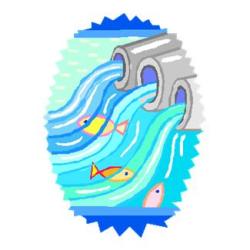Source Institutions
Source Institutions
Add to list Go to activity
Activity link broken? See if it's at the internet archive

In this activity, learners receive a labeled plastic film canister containing a material representing a pollutant (i.e. pencil shavings = a beaver's wood chips). The instructor (or a learner) stands at the front of the room next to a large beaker of clear water and begins to read a story about the history of an imaginary site. As the story comes to the name indicated on a canister, the appropriate learner comes forward, opens the canister, and tells the "audience" what is inside. The contents are then dumped into the beaker of water and the water is stirred. As more and more materials are added, the story periodically asks whether the audience would boat in, swim in, or drink the water. After all materials are added, learners discuss who is responsible for dirtying the water and who is responsible for cleaning it up. This activity is the first of a set of activities on the page and can be used independently or in conjunction with the second activity called "Clean Water: Is It Drinkable?" in which learners design a water filtration system.
- 30 to 45 minutes
- 45 to 60 minutes
- $10 - $20 per group of students
- Ages 8 - 18
- Activity, Lesson/Lesson Plan, Simulation
- English
Quick Guide
Materials List (per group of students)
- Film canisters with labels
- Water in a bell jar
- Wood chips
- Sand
- Charcoal
- Dry grass
- Crushed shells
- Shells
- Organic garbage
- Nails
- Potting soil
- Nylon line
- Toilet paper
- Colored paper
- Newspaper
- Plastic pieces
- Styrofoam
- Dish detergent
- Baking soda
- Oil
- Molasses
- Vinegar
- Data tables
Subjects
-
Earth and Space Science
-
Earth Structure
- Oceans and Water
- Earth's History
-
Earth Structure
-
Life Sciences
-
Ecology
- Ecosystems
- Human Impact
-
Ecology
-
The Nature of Science
-
Science and Society
- Risks and Benefits
- Public Policy
- Ethics
-
Science and Society
-
The Nature of Technology
-
Technology and Society
- Impacts of Technology
- Technology and the Environment
-
The Design Process
- Problem Solving
-
Technology and Society
Informal Categories
- Nature and Environment
Audience
To use this activity, learners need to:
- see
- read
- be mobile
- touch
Learning styles supported:
- Involves teamwork and communication skills
- Uses STEM to solve real-world problems
- Involves hands-on or lab activities
Other
This resource is part of:
Access Rights:
- Free access
By:
- Hood, Carmen
Rights:
- All rights reserved, Access Excellence @ the National Health Museum, 2009
